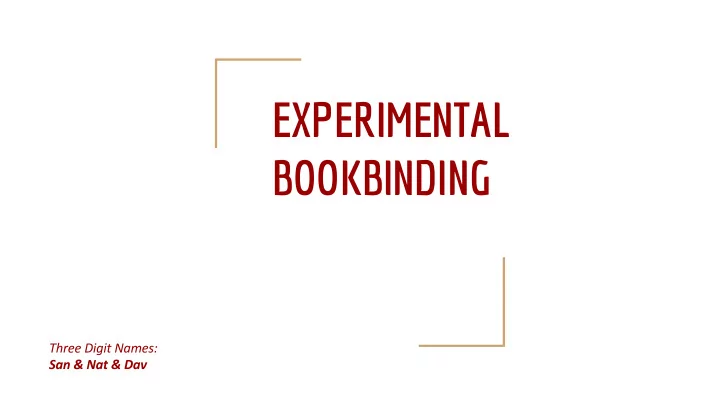

EXPERIMENTAL BOOKBINDING
CONTENTS
ACCORDION BOOK
BRIEF HISTORY 折本 Originated from Asia, specifically from the Tang dynasty (A.D. 618-908), China. Source: Wikimedia Commons Invented to replace scrolls that turned unmanageable due to size and length. Began with long rolls pasted together to be folded alternately one way and the other to produce an accordion effect. Source: Wikipedia Also known as Orihon .
BOOK DESCRIPTION Composed of a continuous folded sheet of paper, often enclosed between two covers. Made simply by folding them back and forth in page-width increments. Can either be expanded outward or kept flat. Consist of various methods of making as the book itself is easily modifiable. Source: Pinterest
ADVANTAGES Great for exhibits and displays as it can stand up and viewed from both sides. Easy to experiment with its form and design. Portable; Convenient for both Source: Pinterest showing and keeping.
Source: Wordpress - Bookzoompa Source: Pinterest
HOW TO MAKE
SADDLE STITCHING
Source: Digital Publishing Florida SADDLE STITCH ‘Saddle stitching’ is a term in the printing industry that commonly refers to staple binding a book along its gutter (spine). Used in magazines or books that have under 64 pages. Pages have to be in multiples of 4. ‘Stitching’ if often used to refer to stapling. ‘Saddle’ due to saddle-like apparatus commonly used in the past. Source: All Business
TYPES Source: Pinterest Source: Johannesburg Printing Company
Saddle Stapler Bone Folder Source: Sea Lemon Source: Bonefolder.com 1. Penknife to score 1. Normal Stapler 2. Ruler 2. Manual Stapling 3. Dull handles of objects 3. Threading 4. Cardboard
Awl Book press Source: Affordable Binding Equipment Source: boothandco.com 1. Regular weights 1. Thumbtack 2. Thick heavy books 2. X-acto blade 3. DIY it! 3. Needle
They should look like this. Arrange them in the order you prefer. Fold your pages in half or as desired. Use a bone folder or score the pages with a penknife in order to get a clean line. Source: Sea Lemon (Youtube)
Keep them in place with binder clips (optional) Place the pages within each other in your desired manner. Source: Sea Lemon (Youtube)
Insert the stapler bullets into the holes, making sure the ends of the stapler bullet are facing inwards. Use a stapler bullet to measure and mark holes in the spine of your soon-to-be book in whatever way you prefer. Using an Awl, or a substitute, create holes where you want them! Source: Sea Lemon (Youtube)
Usually, in saddle stitch binding there will be access paper on the right side of the book. Trim off as necessary. Using an eraser or a substitute, flatten the ends of the staples. You can then use a book press, or a substitute, to further flatten the book for a cleaner look. Source: Sea Lemon (Youtube)
Saddle stitch with thread-demo
Pros and cons of Saddle Stitching Never completely closes Inexpensive Slight overhang of outside pages Simple occurs Not as long lasting Available and accessible Number of pages are limited. Less than 64 is the ideal Result is flat and looks professional Spine cannot be printed on with not much effort ‘Paper Variations’ are restricted due to pages sharing the same piece of paper Source: Paperspecs.com
Source: Paperspecs.com Perfect binding as an alternative Source: bestprinting.com Source: Formax Printing
STAB BINDING
Stab bindings allow us to make books that are not possible with other bindings.
Stab bindings allow us to make books that are not possible with other bindings. We can use scraps of different weights, textures and colors as long as they are the same size or can be cut to the same size.
there are four basic variations of the Japanese stab bind: Kikko Toji (Tortoise Shell Binding), Asa-No-Ha Toji (Hemp Leaf Binding), Koki Toji (Noble Binding) and Yotsume Toji (Four Eye Binding)
Kikko Toji (Tortoise Shell Binding)
Asa-No-Ha Toji (Hemp Leaf Binding)
Koki Toji (Noble Binding)
Koki Toji (Noble Binding)
Why Stab Binding? Creative!
...and this won’t happen to your book
DEMO TIME
Tha
Recommend
More recommend